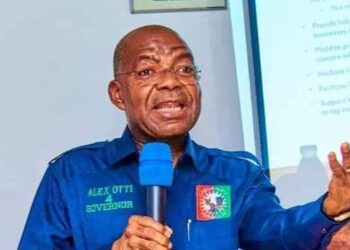The non-discriminatory policy thrust of Governor Kashim Shettima of Borno State to issues, especially that which borders on religion has re-echoed again, this time in Israel, the Holy Land.
Commending the governor for this non-partisan disposition in the secularity of the nation the Nigerian Ambassador to Israel, Mr. David Obasa, pointed out that this position of the Governor is well noted in the Holy Land as far as the Nigerian Pilgrimage is concerned. The ambassador, who was speaking recently in Jerusalem while addressing the 2014 pilgrims from Borno State, said the disposition of Governor Kashim in this regard has become a “Watchword” and a point of reference worthy of emulation. According to him, Borno leads, charging other states to follow.
Ambassador Obasa told the Borno contingent that since assumption of office in Israel, it is his policy to address in person or through his representative various delegations of Nigerians on pilgrimage to the Holy Land. He however pointed out that because of the uniqueness of Borno contingent in composition, he decided for the first time not only to come in person but to lead a delegation of his staff to see and have a taste of the non-discriminating Governor Kashim Shettima.
Speaking on the security imbroglio that engulf Borno and beyond, the ambassador declared, “You are in the eye of the storm. Do not be discouraged. It is a phase that would pass”. He likened the Borno people to the three Hebrew children and Gideon who faced mighty odds but ultimately came out victorious, adding, “To you people of Borno, victory is certain”. Ambassador Obasa charged the pilgrims to be prayerful always and go back to Borno as agents of change.
Earlier, Mallam Ishiaku Shara, the leader of the Borno contingent to the Holy Land, briefed the ambassador on the modalities of selection and composition of the pilgrims. According to Mallam Ishiaku Shara who is also the State Commissioner for Inter-Governmental Affairs, the composition cuts across ethnicity and geographical boundaries. While almost all the tribes in Borno State are represented, the same applied to representative of other ethnic communities residing in Borno.
Mallam Shara further explained that in constituting the composition of the Borno contingent, all categories of people regardless of status were considered. As a matter of fact, he pointed out the haves and the have-nots in various sectors of the communities and called were placed in the same pedestal and considered. To buttress his assertion, some members of the contingent consisting of professors, clerics, civil servants, representatives of various tribes in and outside the state were publically identified before the ambassador and the august gathering.
Random sampling indicate that the composition of the Borno team to the Holy Land this time consist of everybody that is somebody. The programme for the pilgrimage was indeed exhaustive. The Borno contingent made up of 325 pilgrims was divided into seven groups each manned by Borno State government officials and a guide from the Holy Land respectively. They visited several places at different times and experienced the stories of the New Testament where they really happened 2000 years back in order to strengthen their faith in Christ. In the words of Joseph Taba, President of TABAR TOURS, the Christian Travel Agency responsible for Borno pilgrims in the Holy Land, “we at Tabar Tours as Christian living in Galilee, we want to be part of our vision, to tell each pilgrim the life story of Jesus from Nazareth, in our unique way and to give any Christian an unforgettable emotional experience”, adding our motto is “Giving Pilgrims Spiritual Experience in the Holy Land”.
Places visited by the groups within ten days include Mount Tabar, the Church of Transfiguration, Cana of Galilee and the Wedding Church where Jesus performed his first miracle of turning water to wine, Mary’s well, Church of Annunciation where Angel Gabriel met virgin Mary and St. Joseph Church, built on the remains of his carpentry shop, Mount of the Beatitudes where Jesus delivered the sermon on the mount, Tabgha, where Jesus fed the five thousands, Church of Loaves and Fishes and Mensa Christy Church, where Jesus gave Peter the Primacy, Capernaum, the fishermen town that became Jesus new home, the ancient synagogue where Jesus preached, the new church above Peter’s house and the Jordan River, where John baptized Jesus.
Also visited was the Great Sea, the Mediterranean, Mount Carmel (Muchraka) at the point where Prophet Elijah killed the prophets of Baal, to Haifa to the cave where Elijah hid from Jezebel, Stella Maris to visit the Camelite’s Church, the Benedictine Monastery built in 1142 is one of the most beautiful crusader structures in Israel, Ein Karem, the place of Zechariah and Elizabeth, Church of St. John the Baptist which was built above the site of his birth, Church of Visitation where Mary and Elizabeth met, the Church of Nativity in Bethlehem built by Helena, mother of Emperor Constantine on the site that Jesus was born, St. Jerome Chapel, he wrote the “Vulgata” and the Shepherd’s field where the angels announced the birth of Christ.
Similarly, the groups visited Jordan valley, the way Jesus and his family use to walk to Judea, the Dead Sea, the lowest place on earth, Jericho the Palm City to see the location of the Sycamore tree that Zacachacus climbed to see Jesus, Qumran where the essence community lived and where the Dead Sea scrolls were discovered.
In Jerusalem, the groups visited Mount Olives, the best observation point over-looking Jerusalem, Church of Pater Noster, went down the road where Jesus entered the city as a king, on Palm Sunday, Church of Dominus Flevit, Church of Agony ending up at the Garden of Gethsemane where Jesus was arrested. From this point to Mount Zion to see the Last Supper Room (Coenaculum), King David’s tomb and the Church of Dormition where Mary fell asleep, Church of St. Peters in Gallicantu, Western Wall, which is the remnant of the Wall surrounding the Temple Mount.
Also in Jerusalem, the visit extended to the Church of St. Anne and the pools of Bethesda. From Bethesda, various groups respectively walked the path Jesus took to his crucifixion – the Via Dolorasa. The journey started from place of the trial presided by Pontus Pilate and continued through the 14 Stations of the Cross to the Golgata Hall where Jesus was crucified, buried and resurrected. The Church of the Holy Sepulcher built by Helena and other places were also port of calls to the enterprising and never-tired groups of Borno contingent.
In Israel, there was indeed unity of purpose among all members of Borno State contingent to the admiration of other pilgrims from other parts of Nigeria as well other countries. The members danced and sand melodiously, were together in prayer of Agreement especially for peace of Nigeria and Borno in particular, God’s guidance and protection for Kashim Shettima, the State Governor as well 2015 peaceful elections and journey mercy back to Borno from the Holy Land.
To the glory of the Almighty, members of the entourage including officials arrived safely in Maiduguri between March 26 and 29, 2014 respectively. The officials include the State Commissioner for Information and Home Affairs, Mr. Inuwa Bwala, Mr. Pela Chiroma, Special Adviser to the Governor on Land Matters and Dr. Titus Pana, the Chairman of Borno State Chapter of Christian Association of Nigeria.
Izekor wrote from Jerusalem



